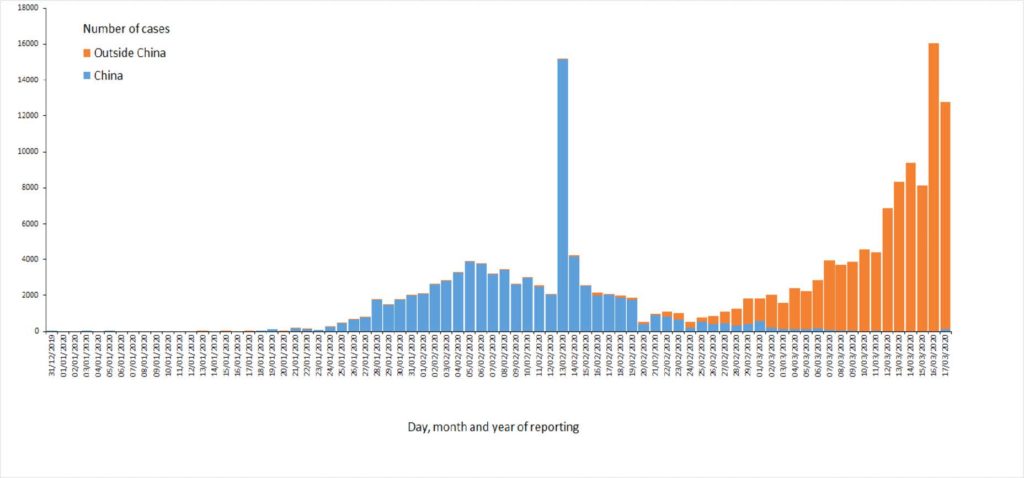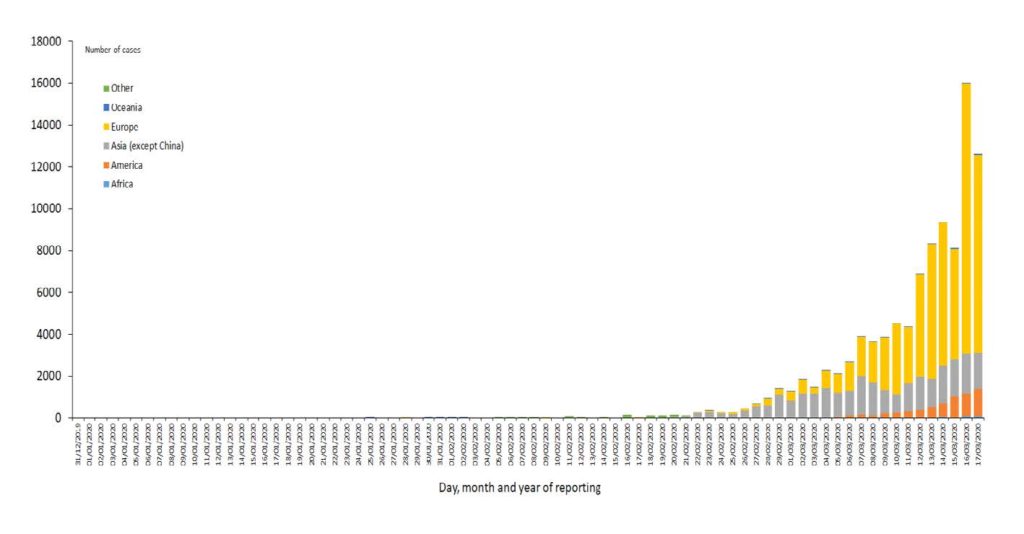COVID-19: the 8 most important information you need to know about
A new Coronavirus disease (COVID-19) causing respiratory symptoms was first identified in December 2019 in China. The World Health Organization declared the outbreak of COVID-19 a pandemic on 11th March 2020, this means COVID-19 has spread worldwide. The number of affected countries continues to expand.
- Description and biological origin
Coronaviruses (CoV) are large families of viruses that cause illness ranging from the common cold to more severe diseases such as Middle East Respiratory Syndrome (MERS-CoV) and Severe Acute Respiratory Syndrome (SARS-CoV). All Coronaviruses have a shape similar to a crown and they were identified for the first time during ’60s, as zoonotic viruses that can be transmitted between animals and humans. Detailed investigations found that SARS-CoV was transmitted from civet cats to humans and MERS-CoV from dromedary camels to humans. Several known Coronaviruses are circulating in animals that have not yet infected humans.
The COVID -19 is the disease caused by the SARS-CoV-2 virus, that means Severe Acute Respiratory Syndrome – Coronavirus – Type 2. The name of COVID-19 take origin from “Co” of corona, “vi” of virus, “d” of disease and “19” because of the year when it was first discovered in China.
- Symptoms
Common signs of infection include: respiratory symptoms, fever, cough, shortness of breath and breathing difficulties. In more severe cases, infection can cause: pneumonia, severe acute respiratory syndrome, kidney failure and even death.
Based on what is known about coronaviruses, those most at risk of serious infection are: people with compromised immune systems (such as people who have cancer); elderly people; people with chronic medical conditions; people in group residential settings; people in detention facilities.
- Spreading
The virus can spread from person to person through: close contact with an infectious person; contact with droplets from an infected person’s cough or sneeze; touching objects or surfaces that have cough or sneeze droplets from an infected person, and then touching your mouth or face.
- Standard recommendation
Good hygiene can prevent infection, and includes: covering your coughs and sneezes with your elbow or a tissue; washing your hands often with soap and water, including before and after eating and after going to the toilet; using alcohol-based hand sanitisers; cleaning and disinfecting surfaces and objects such as mobiles and keys; if you are sick, avoiding contact with others and staying more than 1.5 metres away from people; avoiding large public gatherings.
Surgical masks in the community are only helpful in preventing people who have coronavirus disease from spreading it to others. If you are well, you do not need to wear a surgical mask.
- Testing
You will only be tested if your doctor decides you meet the follow criteria: you have returned from overseas in the past 14 days and you develop respiratory illness with or without fever; you have been in close contact with a confirmed COVID-19 case in the past 14 days and you develop respiratory illness with or without fever; you have severe pneumonia and there is no clear cause; you are a healthcare worker who works directly with patients and you have a respiratory illness and a fever.
There is a global shortage of the test kits that pathologists use to diagnose COVID-19. This is why hospitals are using targeted testing instead of widespread testing.
- After testing
If you have been diagnosed with COVID-19 and you have serious symptoms you will be kept in hospital and isolated from other patients to prevent the virus spreading.
If your doctor says you are well enough to stay home even if you got the COVID-19, you should self-quarantine at home respecting standard recommendation. Staying at home in self-quarantine means you: do not go to public places such as work, school, shopping centres, childcare or university; avoid cooking for or caring for other members of your household but ask someone to get food and other necessities for you and leave them at your front door; do not let visitors in — only people who usually live with you should be in your home.
You do not need to wear a mask in your home but you have to avoid close contact with people anyway. If you need to go out to seek medical attention, wear a surgical mask to protect others.
- Treatment
COVID-19 is a new disease, so there is no existing immunity in our community, there is no treatment and no vaccine for, but medical care can treat most of the symptoms. Antibiotics do not work on viruses.
- Worldwide situation
Based on the number of cases, the World Healt Organization announced COVID-19 as an outbreak of a pandemic on 11th March 2020.
Since 31 December 2019 and as of 17 March 2020, 180.159 cases of COVID-19 (in accordance with the applied case definitions and testing strategies in the affected countries) have been reported, including 7.103 deaths.
Distribution of COVID-19 cases worldwide, as of 17 March 2020:

Distribution of COVID-19 cases by continent (except China), as of 17 March 2020:

GIORGIA DI BELLA 5BBS



